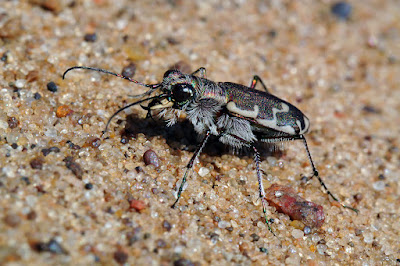"Spiders are not only essential to the balance of nature but are also fascinating creatures that inspire awe and curiosity."
— David Attenborough
For lack of rain, the Wisconsin River near Sauk City is rather low once again, offering opportunities for exploration and exposing more habitat for the creatures that thrive along its banks. When the water level drops, the shoreline becomes easier to navigate, allowing for extended treks and a closer look at the fascinating world of creepy-crawlies that emerge. Although autumn is well underway, we're still not at peak fall colors. Most of the trees along the river are holding onto their green leaves with some showing hints of yellow.
During this outing, there were several Arctosa littoralis—Shoreline (or Beach) wolf spiders—scurrying across the exposed terrain. These spiders are perfectly adapted to life along the riverbanks, their cryptic coloration helping them blend into the surroundings as they hunt and move across the sandy habitat.
They're known to burrow under sand or other beach debris, which helps them stay hidden from predators (mainly wasps) and better positioned to ambush prey. Typically nocturnal predators, they emerge at night to hunt for insects. During the day, they remain concealed under sand to avoid detection, but when disturbed, they'll make a run for it to avoid getting crushed.
Their hiding behavior is facilitated by their ability to blend into the sandy habitat thanks to their coloration, which acts as some of the best camouflage rendered by natural selection. Unlike spiders that rely on webs, wolf spiders like Arctosa littoralis are agile hunters, and their excellent eyesight helps them spot prey even in low-light conditions. They react quickly when they feel threatened. When sufficiently bothered, they can literally jump away, with larger individuals capable of leaping about a foot at a time, doing this repeatedly until they are out of danger. It's kind of adorable, actually.
How about some macro close-ups?
Some individuals exhibit drab patterns and colors, blending seamlessly into their sandy surroundings, while others display more vibrant hues with warmer tones. These striking variations not only showcase their beauty but also serve as a fascinating reminder of their adaptability to different micro habitats.
I would like to get a better photo of their fangs, but I don't wish to handle them. As much as I admire them, they are a little creepy—it's part of their attraction, though.
Appreciate this warmer-toned one ...
Their amazing eyes ...
Such astonishing camouflage!
The trees along the shore were bustling with a gazillion Yellow-rumped Warblers. This time of year, they don’t sing; instead, their cheerful chip notes sound like a persistent 'check' as they flit from branch to branch, searching for insects and berries. While their vibrant yellow butt-patch adds a splash of color to the scene, these warblers are so common that most birders wouldn’t give them a second glance. However, their abundance is a testament to their adaptive success, thriving in a variety of habitats and making them a familiar autumn sight. It really is a good bird.
I brought my digi-rig with me and spent some time photographing the fall-plumaged YRWAs.
Farewell for now, but they’ll return in the spring, usually in late March for those of us in southern Wisconsin. Their arrival signals the promise of May's glorious neotropical songbird migration, which, unfortunately, seems to feature fewer members with each passing decade of my birding experience. At least this species remains abundant, and they could, down the road, serve as genetic stock for evolution to potentially create new varieties of wood warblers, perhaps thousands of years from now. When observing the current Parulidae family, we see members that are strikingly similar due to recent speciation, alongside others that are quite disparate, having speciated much longer ago. This suggests that hundreds of warbler species likely went extinct long before there were humans in North America to witness them.
Lastly, there were still some tiger beetles, but only Bronzed now. Recall last year I found them up to the first week of November, which was the first time I had ever observed them so late in the season. We've had a few nights of freezing temperatures, but we're heading into a warming trend for a week or so. It'll be interesting to see if they re-emerge.
Perhaps farewell to the tiger beetles, as well!
October highlights vanishing seasonal life, through migration, hibernation, decay, and death. Each species plays an important role in our local ecosystem, reminding us of the diversity of life that thrives around us during the warm months. As we observe their beauty, behaviors, and interactions, let’s continue to appreciate and do our best to protect these remarkable creatures and their habitats for the future—and you can't do that by rolling back hundreds of environmental programs and regulations.
All images © 2024 Mike McDowell




















